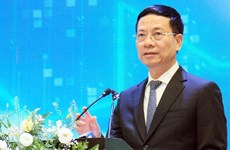The Journey to economic integration
The ASEAN Economic Community gets a lot of mention these days, but ASEAN’s journey of economic integration has actually been underway for decades.
 Illustrative image (Source: straitstimes.com)
Illustrative image (Source: straitstimes.com)The economic linkages that bind ASEAN together have taken root through different channels over time. This includes different ASEAN countries sharing complementary roles in manufacturing, the improved ease in moving products across borders, and other mechanisms that facilitate the smoother flow of goods, services and capital, and skilled labour across the region.
This contributes to the narrative of ASEAN being one of the most dynamic regions in the world, and a key contributor to world economic growth. Economic integration —and the doors of opportunity it opens— has brought concrete financial and economic benefits to hundreds of millions of people in ASEAN.
If it were a single country, ASEAN would be the seventh largest economy in the world and the third largest in Asia. From 2007 to 2014, its combined GDP nearly doubled to 2.57 trillion USD.
Tariff s among ASEAN countries stand at nearly zero today, bringing down the price of goods and increasing choices for consumers. ASEAN has also become a world-class investment destination, attracting 136 billion USD in foreign direct investment in 2014, thus creating more economic and employment opportunities for its population.
Looking ahead, the further liberalisation and integration of ASEAN’s economies after the launch of the ASEAN Economic Community in December 2015 is expected to bring more benefits for the region. Collectively, ASEAN is projected to become the world’s 4th largest economy by 2050.
Formally established on 31 December 2015, the ASEAN Economic Community (AEC) is a milestone in the ongoing agenda for regional economic integration of ASEAN. Adopted by the ASEAN Leaders in November 2007, the AEC Blueprint (2008-2015) has helped chart the region’s journey towards the formal establishment of the AEC, characterised by: (a) a single market and production base, (b) a highly competitive economic region, (c) a region of equitable economic development, and (d) a region fully integrated into the global economy.
As an integrated community, ASEAN aims to be a region where there are simplified rules, lower tariff s and harmonised standards and closer regulatory cooperation, greater transparency, a talented, well-educated pool of workers and a large, vibrant consumer base. The story of ASEAN’s economic cooperation and integration spans more than four decades, its foundation having been planted through the seventies and picking up pace in the nineties.
As early as 1977, ASEAN put in place the ASEAN Preferential Trade Agreement. The steps toward deeper economic integration quickened with the Framework Agreement on Enhancing ASEAN Economic Cooperation, which covered areas ranging from trade, industry, minerals and energy; finance and banking; food, agriculture, and forestry; transport and communications.
This led to other ASEAN trade accords, including the 1992 ASEAN Free Trade Area (AFTA) t hat is largely responsible for tariff reductions within the region. AFTA aimed to boost ASEAN’s competitive edge as a production base through the elimination of tariff s and nontariff barriers, and through the attraction of more foreign direct investment into the region. Other agreements that pushed economic integration range from the ASEAN Framework Agreement on Services in 1995, the ASEAN Trade in Goods Agreement in 2010 which consolidates ASEAN commitments and initiatives on trade in goods, and t he ASEAN Comprehensive Investment Agreement in 2012.
By 2003, A SEAN Leaders declared t he formation of the ASEAN Economic Community as the goal of regional economic integration within the ASEAN Community.
In 2007, they adopted the Blueprint that served as the master plan guiding the establishment of the ASEAN Economic Community in 2015, a completion date that had been moved up from 2020.
As of end-October 2015, the ASEAN Economic Community Scorecard, which tracks the progress of the measures in the Blueprint, showed that ASEAN had implemented 92.7 percent or 469 out of 506 measures it had committed to undertake. In terms of the four areas of integration under t he Economic Com mu n it y, Member States had fulfilled 100% of the measures relating to equitable economic development and ASEAN’s integration into t he global economy. T he remaining key measures will be prioritised for implementation by end-2016.
At the same time, ASEAN Leaders have acknowledged the need to continue working on regional economic integration.
In the area of trade liberalisation, ASEAN Member States will need to continue working on reducing non-tariff barriers, which Malaysian Prime Minister Najib Tun Abdul Razak has said remain “too extensive” and hinder free and open trade across ASEAN economies.
ASEAN Leaders have also committed to ensuring that the continued integration process is inclusive, and serves to narrow the development gap among and within ASEAN Member States.
These considerations are also why ASEAN’s newer members —Cambodia, Laos, Myanmar and Vietnam— have until 2018 to fully adopt the ASEAN Economic Community ’s tariff liberalisation commitments. While regional integration efforts are underway, ASEAN has also put in place other frameworks to narrow the development gap, such as the Initiative for ASEAN Integration.-VNA












